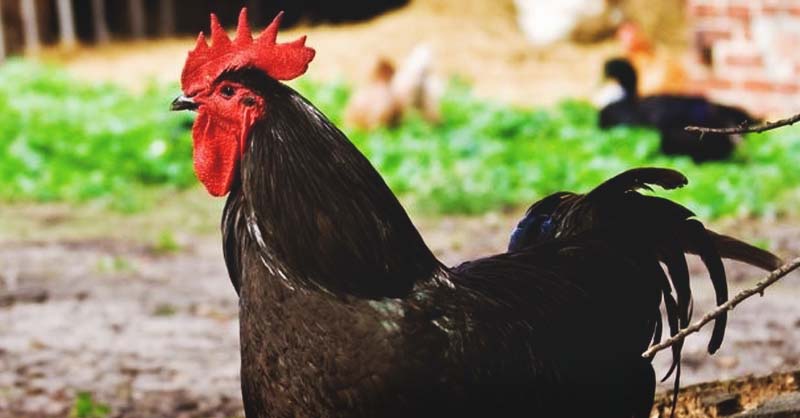Meet the Giant of Jersey! Anyone with a small backyard should not Own this gigantic bird. Nonetheless, the enormous advantages of these gigantic birds will be appreciated by a chicken keeper with plenty of space.
Jersey Giant chickens are a great match for any homesteader looking for a excellent layer that will make excellent eating at the end of their productive egg producing life. They are arguably one of the world’s largest breeds.

About Jersey Giant Chickens
Two brothers in Burlington, New Jersey, were the first to create this massive breed of chicken in order to replace the main source of poultry meat at the time: turkey.
Jersey Giants were bred from Dark Brahmaas, Javas, and Langshan hens, resulting in a massive bird. The American Poultry Association accepted the Black Jersey Giant into the Standard of Perfection in 1922.
The White and Blue Jersey Giants were eventually accepted into the Standard of Perfection throughout the following several years.
Jersey Giant Characteristics

1. Size and Weight
These gigantic birds do indeed live up to their name. Jersey Giants are said to be the world’s largest purebred chicken breed, according to many people.
Roosters range in size from 11 to 15 pounds, and they stand around 24 inches tall. The Jersey Giant hen, which weighs 9 to 11 pounds and is around 17 inches tall, is a little smaller.
2. Temperament
Due to their sweet and docile personalities, Jersey Giants are often referred to as gentle giants. Even the crowing roosters are laid-back.
Hens are not particularly broody, but they are poor moms. The huge birds may be clumsy and shatter eggs, injuring tiny chicks, despite their best efforts.
3. Egg Production
Jersey Giants have superb egg production despite their significant bulk. Because of their prolific nature, a single hen can lay up to 260 large brown eggs in a single year.
4. Meat Production
You won’t be disappointed in the amount of meat produced by Jersey Giants because they were originally bred for meat production. Jersey Giants, on the other hand, won’t suit your needs if you’re seeking a fast growing bird.
The Jersey Giant cockerel takes around six months to reach ten pounds, and it takes even longer to reach a slaughtering size.
Taking Care of Jersey Giant Chickens

1. Feeding and Nutritional Needs
When contemplating a Jersey Giants purchase, it’s important to consider how much food they’ll eat.
Jersey Giants are omnivores and will eat a lot because of it. Begin by feeding your hens a high-quality chick starter.
Switch your hens to a high-quality egg laying food around the age of 18 to 22 weeks, while supplying additional calcium in a separate dish.
2. Housing and Fencing
You can’t afford to sacrifice space for these birds when it comes to housing. To guarantee that everyone has enough area, the chicken coop requires 5 square feet per bird.
Jumping from roosts may harm the legs of the Jersey Giants because they are so big. When placing roosts, remember to keep them no more than 18 inches off the ground.
Provide your hens around 10-12 square feet each for the run area.
3. Health Issues and Care
These chickens are actually quite healthy, and they don’t have a lot of health concerns. It’s vital to be certain that they don’t have to leap too far from roosts, nesting boxes, or the coop, as I previously stated.
4. Breeding
The Jersey Giants are a simple breed to raise since their feathers do not have a complicated color pattern.
Be aware that due to the huge size of the eggs, they may take a few days longer than normal, sometimes up to 21 days.
Breed Alternatives
1. Cochins
For a variety of reasons, cochins may be a excellent substitute for Jersey Giants. Although they are comparable in size to Jersey Giants, these birds are a little smaller.
Cochins are excellent moms and provide some color choices that aren’t available in Jersey Giants, such as being more colorful in cold weather.
2. Brahmas
Brahmaspood be a excellent alternative breed for Jersey Giants, considering the fact that they were utilized in the breeding of Jersey Giants.
Brahmas are large birds with feathered legs and a high meat output. There are also a variety of color changes that these birds may offer.
Fun Facts about Jersey Giants

Because they are similar birds, many chicken keepers have a tough time telling the difference between Black Jersey Giants and Australorps. viewing the bottoms of their feet can be a helpful way to discern between these two breeds. Whites or light pink foot pads are seen on Australorps, while yellows are seen on Jersey Giants.
For farmers who need a dual-purpose bird that does not go to waste at the conclusion of its laying days, the Jersey Giants are an excellent option. A big family could eat six or more extra roosters if you’ve got them. Jersey Giants may be a beneficial addition to the flock as long as you have enough room.

